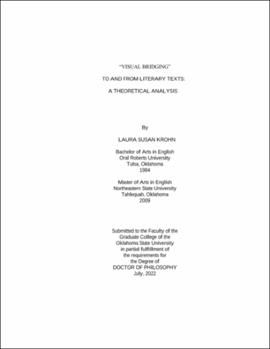| dc.contributor.advisor | Zhao, Guoping | |
| dc.contributor.author | Krohn, Laura Susan | |
| dc.date.accessioned | 2023-04-05T16:21:01Z | |
| dc.date.available | 2023-04-05T16:21:01Z | |
| dc.date.issued | 2022-07 | |
| dc.identifier.uri | https://hdl.handle.net/11244/337293 | |
| dc.description.abstract | This theoretical study examines the use of visual images as a bridge to and from printed literary texts for secondary-level and higher-education students. Elementary educators and literacy experts have long embraced the visual as a means through which pre-readers begin to “read” stories and for supporting young readers’ comprehending verbal texts; however, secondary English educators are not as trained in effective pedagogy that embraces the visual, even though most older students are already comfortable with multimodal techniques and skilled at “reading” those texts outside the classroom. This theoretical study develops a concept of Visual Bridging to help these students cross into unfamiliar or uncomfortable texts using the familiarity and comfort of visual imagery, where they hopefully find interest, curiosity or conviction in the literature and then bridge back out to apply meaning and value to their own lives. Drawing on Roland Barthes’s reader-response and reviewer-response theories, the Visual Bridge relates to Barthes’s concepts and application of studium and punctum in photographic images. Included in the study are practical exemplars which demonstrate how classroom practices using this strategy allow students space to engage in creative ways with literary themes, resulting in meaningful aesthetic experiences which hopefully make them more willing to engage with future literary texts. Visual Bridging may also help students enter unfamiliar cultures found in literary texts they previously did not want to read, increasing their knowledge, understanding of, and empathy for others, as well as for themselves in their own place, time, and culture. The presentation and exploration of this concept articulates a hopeful vision for educators and teacher-education programs, concluding that students can find new perspective, beauty, punctum and personal relevancy in any literary work. | |
| dc.format | application/pdf | |
| dc.language | en_US | |
| dc.rights | Copyright is held by the author who has granted the Oklahoma State University Library the non-exclusive right to share this material in its institutional repository. Contact Digital Library Services at lib-dls@okstate.edu or 405-744-9161 for the permission policy on the use, reproduction or distribution of this material. | |
| dc.title | "Visual bridging" to and from literary texts: A theoretical analysis | |
| dc.contributor.committeeMember | Bailey, Lucy | |
| dc.contributor.committeeMember | Harris, Ed | |
| dc.contributor.committeeMember | Witte, Shelbie | |
| osu.filename | Krohn_okstate_0664D_17825.pdf | |
| osu.accesstype | Open Access | |
| dc.type.genre | Dissertation | |
| dc.type.material | Text | |
| dc.subject.keywords | aesthetic pedagogy | |
| dc.subject.keywords | English language arts education | |
| dc.subject.keywords | literary literacy | |
| dc.subject.keywords | multimodal texts | |
| dc.subject.keywords | Roland Barthes | |
| dc.subject.keywords | visual images | |
| thesis.degree.discipline | Education | |
| thesis.degree.grantor | Oklahoma State University | |
